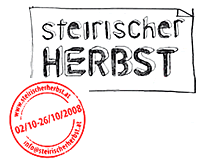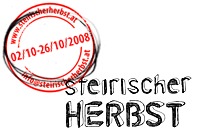Icon - 01.01.2008
“Confettification”
»online
“Confettification.” This made-up word is the best way to describe an
event that took over a public square in Graz this autumn. Amid a flurry
of coloured circles, face painting, fireworks and French toast was a
temporary building. But all of it was called architecture, and
everything – including this article – was part of a bigger performance
called The Theatre.
The word “confettification” comes from the project’s creators,
International Festival, and reflects their irrepressible, effervescent
characters. Winner of the accolade Swedish Architect of the Year 2007,
the practice was founded in 1993 by architect Tor Lindstrand and
choreographer Mårten Spångberg. What they do, in the simplest terms, is
attempt to fuse architecture and performance – and they travel the
world doing just that with a band of itinerant dancers, filmmakers and
designers.
The Theatre’s foyer – which is also used as a public bar, restaurant
and studio space – is a plastic greenhouse covered in giant confetti
circles and lit up like a Christmas tree. With a yellow-decked
forecourt and flanked by four navy-blue shipping containers, it is a
definite oddity in Karmeliter Platz, a serene public square in central
Graz. The space leads to a theatre for 150 people in a large tent-like
structure, where around four performances a day are taking place over
five weeks before the project gets packed up into the shipping
containers and moves off around Europe. The punters are trickling in
and I have a ticket for the last performance of the night. However,
International Festival would argue that its own performance started
long before the building work began.
Construction was preceded by a strategy of engagement with the locals.
Coloured circles were plastered over the walls, ground, lampposts and
billboards of the city. There was a party on top of a hill and 50
fireworks were set off. Meanwhile, the site for The Theatre was marked
off and people were invited to watch films and provided with popcorn,
face painting and T-shirt “pimping”.
“People often talk about the link between architecture and dancing. But
I’ve never seen any examples other than a stupid set, done with
plywood,” says Lindstrand when we meet in the finished theatre. He
leans back on a plastic chair and looks into the doorless foyer, which
is filled with people selling tickets, using the free wi-fi and
drinking coffee, accompanied by filmmakers milling around the action.
Cedric Price’s endlessly theorised Fun Palace clearly informs the
irreverent programming of the space, which is enthusiastically in
favour of the popular, the mainstream and the overstated. International
Festival likes to challenge the space between architecture and
performance. “People think architecture is the Parthenon – something
you might see twice in your life – and performance is sunshine,” muses
Spångberg, adjusting his giant spectacles. “But we like to say
architecture is sunshine, performance is the Parthenon.” At first this
sounds meaningless, but all he means is that we’d enjoy architecture a
lot more if we saw everything around it as part of it and equally
special.
The notion of socially activating a site and the idea of an invisible
architecture that is about people, networks and processes has become
fertile ground. The French architect Patrick Bouchain, for instance,
promotes architecture that is not so much about the structure as it is
about learning and inhabiting. For a housing project in Calais, he
erected a temporary public restaurant on the site before construction
began, and then during construction invited architecture students to
come on site to learn about the process. Many younger architects, such
as London’s AOC, Brussels’ City Mine(d) or Berlin’s Raumlabor and
Performa 891, are treating buildings as a socially oriented process of
public interaction.
“There is no chance of telling anyone what to think anymore,” says
Lindstrand. “What we can try to do is to reformulate utopia into tiny
utopias. The tiny utopia of someone standing over there making French
toasts.” Spångberg chips in: “It’s wonderful to think of all these kids
after face painting, when they are sitting on the tram being all
beautiful with a butterfly face or whatever.” The Theatre is a kind of
choreography of light touches that resonate across the city. Rather
than a single focus, International Festival creates an atmosphere, a
series of ephemeral yet hopefully lasting effects. Where others go for
essence, the practice prefers the “less is a bore” school of thinking,
but instead of building big they scatter or multiply. This is city
activation post-Guggenheim, beyond the Bilbao effect. It is tired of
starchitecture. It’s almost as if, having become such a public
spectacle, architecture now needs to disappear for it to continue to be
challenging.
“When you come here and sit down you are already in the show,” says
Spångberg. “Building a see-through foyer shows we have set up something
different. With ordinary theatre bars they propose a certain kind of
exclusivity of a bourgeois audience, with glasses of prosecco and small
triangle sandwiches. Here we don’t even have a fucking door.”
Although their position claims to be beyond architectural criticism,
the building has to come under some aesthetic scrutiny – because unlike
the Fun Palace, which has no walls or floors, its physical presence
here is tangible. It has the feel of a bouncy castle, transposed from a
funfair into a formal city square. It’s a travelling circus
architecture of multi-coloured lights and pop in the form of a garden
centre. It’s impossible not to question the taste, but it’s like
complaining that the candles on your birthday cake clash with the
icing. It’s hardly the point.
“We want to expand the field of what architecture could be,” says
Spångberg. “Yesterday, we asked the woman who was working in the bar
serving coffee if she’d like to DJ. She said yes and it was quite
weird. People were stomping the floor to this Serbian turbo-folk.”
Spångberg and Lindstrand exchange glances and laugh. “But if a curator
or critic comes in at that point they see only architecture. For us it
is also life that is produced within a frame. This is part of the
piece. This is what we do.”
Beatrice Galilee


